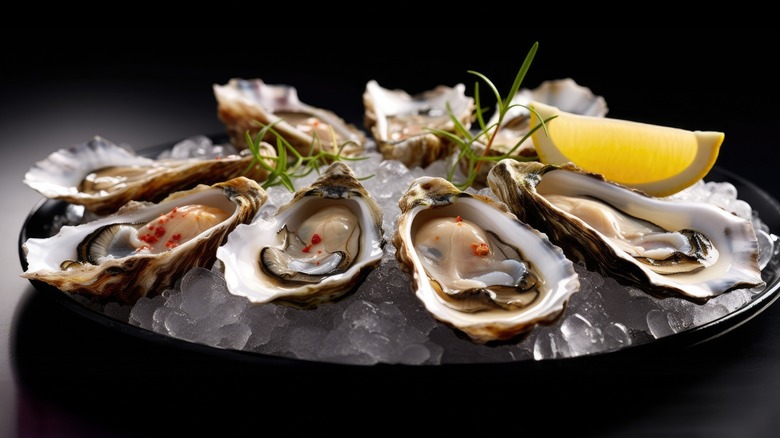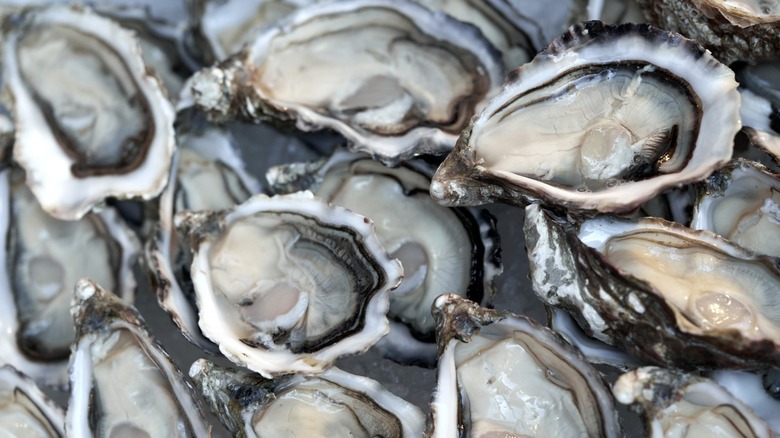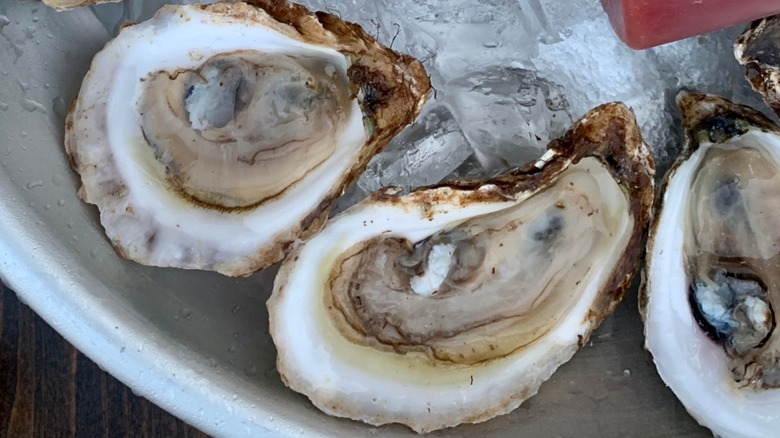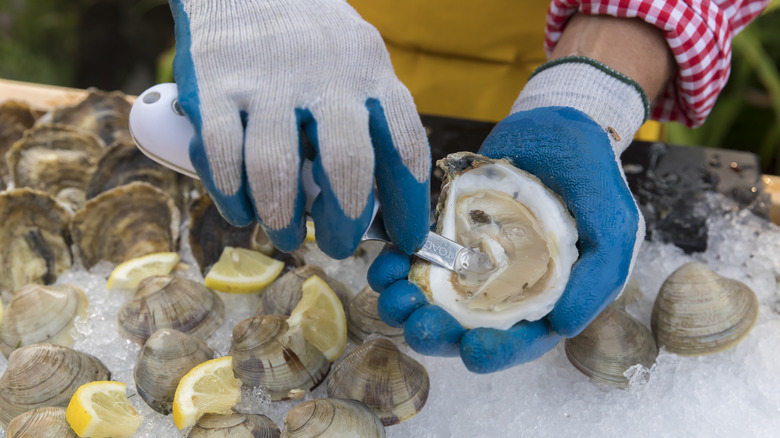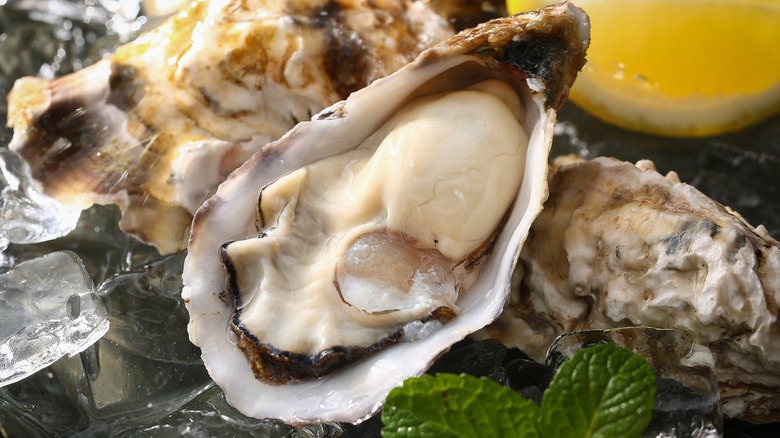What's The Difference Between West And East Coast Oysters?
The waiter hands you a menu filled with columns separated into East Coast and West Coast oysters. The categorized lists offer a variety of oysters taken from different locations, but what does it mean for your order? Understanding the differences in shape, flavor, and texture can help you choose from a lineup of shells taken from the Atlantic waters of the American East Coast and those collected from the Western Pacific Ocean.
In general, East Coast oysters are teardrop-shaped, have firm, chewy meat, and have a stronger and saltier flavor while the smaller West Coast oysters are more round, have a sweeter and more complex taste, and have scalloped shells. East Coast oysters also take up a little less space in the shell, though size can vary. And, within each coastal type of oyster, there are many different varieties.
Regional differences matter when it comes to oysters, as the waters in which these delectable bites are farmed can yield saltier tastes for the oysters you intend to consume. Whether you prefer to slurp raw oysters with an assortment of accoutrements or crunch on oysters that have been fried to golden perfection, having an idea of what you're getting yourself into can impact not only the meals you make at home but also the dishes you choose to partake in at local restaurants.
What are West Coast oysters?
Not simply hailing from the Western shores of the United States, West Coast oysters can be collected from Pacific Ocean waters spanning from Alaska down to Chile. Though oysters farmed in this region tend to run on the smaller side compared to their eastern counterparts, these bite-sized bivalve mollusks pack plenty of flavor. Within the category of West Coast oysters, you'll find a range of options, from Washington's Kumamoto oysters to Drakes Bay, Marin Coast, and Hog Island oysters gathered in bays along California.
West Coast oysters offer clean, fresh flavors with fruitier tasting notes and plump, creamy textures in each bite. As a generalization, West Coast oysters are known for their mildly briny and savory tastes, as warmer waters and reduced salinity levels tend to impact the oysters' overall flavor profile. When placed next to oysters collected from the East Coast, you'll also be able to notice a difference in shell size and cup depth long before any piece reaches your lips.
What are East Coast oysters?
East Coast oysters can be farmed along the Atlantic Ocean and the Gulf of Mexico. With a noticeably larger appearance, the shells of fleshy oysters taken from the East Coast are usually in a teardrop shape, and the exterior of the shell itself is smooth. Once shucked, these morsels offer a robust, salty, and mildly nutty flavor. Oysters collected in frigid New England waters often take longer to mature and present a more textured, if not sharp, saline flavor.
From the buttery Chesapeake oysters to the briny mid-Atlantic varieties, the length of oyster maturation will also impact the taste. Within the category of East Coast oysters, the firm, briny Atlantic oysters and the mineral Belon or European flats tend to dominate menus. If you're looking for meatier morsels, oysters taken from the East Coast are equally suited for serving on half-shell platters as they are for being cooked on the grill.
West Coast oysters have a more complex flavor
Eating oysters can be compared to wine tasting, sampling cheese, or sipping on whiskies from different parts of the world. The tasting notes of oysters can be separated and identified according to their flavor profiles, textures, and finishes, and the region in which oysters mature will impact the overall experience. Known as merroir, oysters' unique flavors can depend on a host of variables including water temperature, salinity, and water quality.
While most meaty East Coast oysters generally offer simpler and more straightforward flavor profiles, the smaller West Coast varieties can present layers of briny, fruity, and complex notes for oyster lovers. Just as you would sample wine varieties, trying different kinds of oysters can help you familiarize yourself with the various tasting profiles and identify which ones you prefer. From saltier, more mineral flavors to sweeter, creamier, and buttery notes, East and West Coast oysters offer plenty of culinary territory to explore.
East and West Coast oysters look different
The aquatic environments in which oysters mature impact the size and appearance of both the shells and the meat within. Whether waters are filled with flowing seaweed or crashing waves in a more distressing environment, these characteristics can be seen before the oyster is split in two. East and West Coast oysters can generally be identified by their shape. A smaller, rounder, and more textured shell is characteristic of West Coast oysters, while East Coast oysters have larger teardrop-shaped shells that appear more polished and smooth.
The shells of West Coast oysters are also typically wavy or fluted around the edges. And when it comes to color, the thicker shells of East Coast oysters can be dark blue-green, while West Coast oysters often present thinner shells that are gray or off-white in appearance. Depending on the dishes you are preparing at home and how you are planning on presenting your oysters, the differences in shell color and size of the oysters themselves can impact the recipes you're hoping to serve.
East Coast oysters are chewy, West Coast oysters are creamy
Oysters growing in nutrient-dense waters develop a plumper texture than those that reach maturation in colder wasters. East Coast oysters are a perfect example, as these bites are more firm and springy than their West Coast counterparts. The meat's texture can make a noticeable difference if you're planning on frying or grilling oysters. Though varying consistencies may go unnoticed by the oyster-tasting novice, East and West Coast oysters can present very different mouthfeels.
West Coast oysters are often creamy and buttery and offer a texture that's similar to custard. For those wanting a chewier experience, however, East Coast oysters often deliver a more solid, almost meaty texture that takes more effort to bite down on and swallow. Though oysters can be a divisive order, understanding these sometimes subtle variations can help you convert skeptics and prepare recipes like oysters Rockefeller that are devoured without hesitation.
